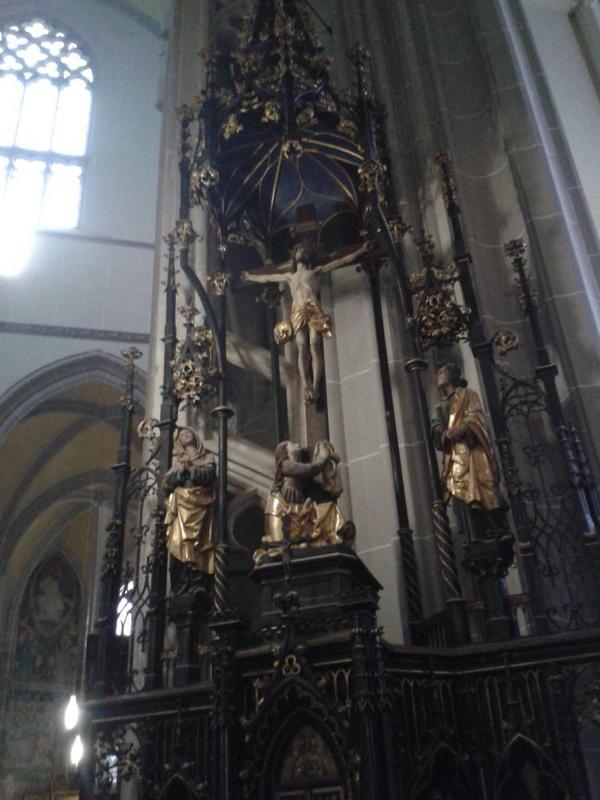We took a cheap flight with Tarom to Vienna and drove all day to Kosice in Eastern Slovakia. We missed the turning to Eger because Hungary is very badly signposted, were depressed by Miscolz and I was elated to reach beautiful Kosice as dusk fell. Kosice Timisoara and Cluj in Romania are the three most beautiful Hungarian cities among many. All the most beautiful, Budapest excepted, lie outside Hungary, which adds to Hungarians' genetic melancholy.
At university the only time I did any hard work was when I studied Hungarian 19th and 20th century history. I chose Hungary at random as the Eastern European country to take an interest in. Over the last twenty years I have slowly come to suspect I chose the least interesting country in this fascinating part of Europe. Slovakia, on the other hand, where I lived for six months in 1990-1991, without taking great interest in it, turns out now to be utterly enchanting.
Like Romanians Slovaks were until recently peasants. In Slovakia as in Transylvania the landowners were Hungarian. In the towns lived Hungarians, Germans and Jews. Now the Slovaks like Romanians dwell in cities that they did not build. Towns that remind me of the beautiful towns in Southern Ireland built by the Protestant Ascendancy.
This is German Europe, destroyed by Hitler's irrational racial theories. How paradoxical that the Jews, who embodied so much of German, and later Hungarian, civilisation were murdered by people who believed in German supremacy.
Kosice, like Bucharest, is a city of one street. In Kosice's case one of the loveliest in Europe, Hlavná ulica, which translates as High St or Main St, and contains a serried rank of baroque buildings. The rather pompous author of my 1999 edition of the Blue Guide was very upset that the street had been pedestrianised and this is something I too usually dislike. I don't think it was pedestrianised when I came here so recently in 1992 but I can't remember. Anyway, I think it works pretty well. I wish Bucharest does a similarly good job with Calea Victoriei if they must pedestrianise it, but I have few hopes.
The centre of the street is the wonderful, gothic St. Elizabeth's cathedral, which is the easternmost gothic cathedral in Europe. Kosice no longer is home to large numbers of Germans or Hungarians since the post-war ethnic cleansing it still has a fair number of Orthodox and Uniates. You feel that are at the edge of Catholic Europe, where it meets the steppe, that below the baroque and the age of reason is something else, older, more visceral..
We didn't explore Kosice before we drove across Slovakia looking for wooden churches and found not only them but the peerless Bardejov. Eastern Slovakia is a paradise for a lover of gothic churches and particularly gothic altars. The church of St. Aegidius, Bardejov, has seven of them each of extraordinary beauty. The large church was full at 12.00 Mass on a Friday. I wondered if it was some special saint's day but was told that every 12.00 Mass is full.
It was unseasonably cold. it rained from time to time. Bardejov town square is perfect and the closed grey sky gave it a haunted quality like the opening chapter of Dracula. This is not touristland.
 |
| Kosice Cathedral
We drove back to Vienna after two days in Eastern Slovakia stopping at the wonderful Spiš castle, the surprisingly interesting old town of Prešov (the Blue Guide did not tell us to expect so marvellous a place) and spending our third night at the best place of all, the very beautiful town of Levice to which I shall return. We stayed at a very pleasant hotel, staffed by nice people, the U Leva.
The next morning was Sunday and while my friend slept I went to Mass. I couldn't understand the words, of course, and felt as always that this was something very different from the Mass as it was said from the time of the conversion of Europe to the early 1960s when Mass in the vernacular came in. It is the reason why the Catholic Church unlike the Orthodox, does not feel old, but seems as if it dates from the John F Kennedy epoch. I thought these thoughts, tried to pray and studied the faces of the agricultural labourers who made up the congregation, mostly over forty, more women than men. How very fine it is to live or even to visit a country where believing in God is not a lifestyle choice but as normal as the sun rising each morning and, importantly, where religion is a real religion, full of saints and rules, not polite, understated Anglicanism.
On our fourth and last day we had the most beautiful journey to Vienna. I usually prefer the works of man to those of God usually but the avenues of trees, their leaves turning a bright orange, which strongly reminded me of cathedral quires, were more beautiful than any. No one wrote a poem as beautiful as leaves in autumn.
We came by chance on the Liptov village museum, founded in 1991, where village buildings and a church - most from a village flooded to make way for a reservoir -have been collected. Every Sunday they have a concert of folk music and stalls home-made excellent food and drink. We luckily were the only foreigners. Then drove through the Tatras towards Vienna.
|




I'd add Szeged to your list. Oradea has lots of down-at-heel charm. And I'd probably add Subotica as well, had I been there.
ReplyDeleteI agree that they are lovely. Subotica though not beautiful or old is very dear to me. Satu Mare is wonderful, very beautiful, but Timisoara, Kosice and Cluj are my three favourites.
ReplyDeleteSzeged was rebuilt in the early twentieth. century. But it improves with age.
ReplyDelete